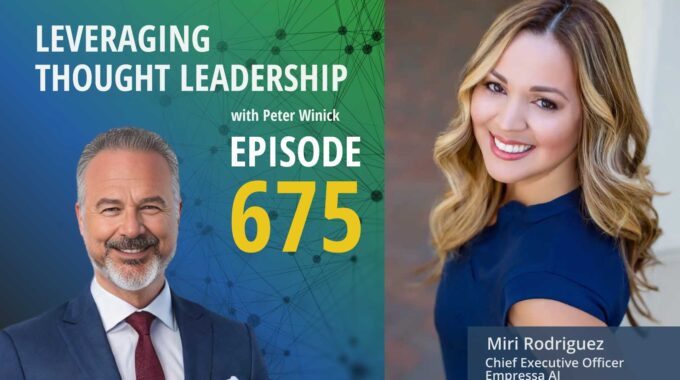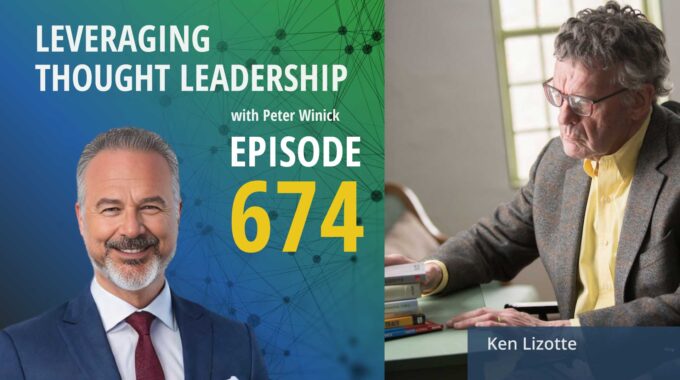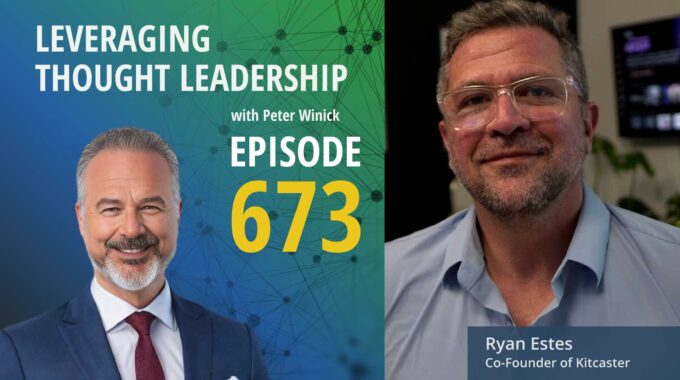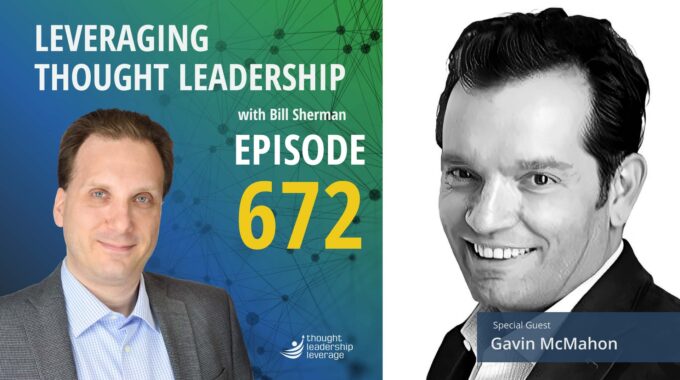Building Brand Love Through Storytelling This episode explores how storytelling can drive inclusion, purpose, and…
Empowering Changemakers to Embrace New Approaches | Heather Hiscox
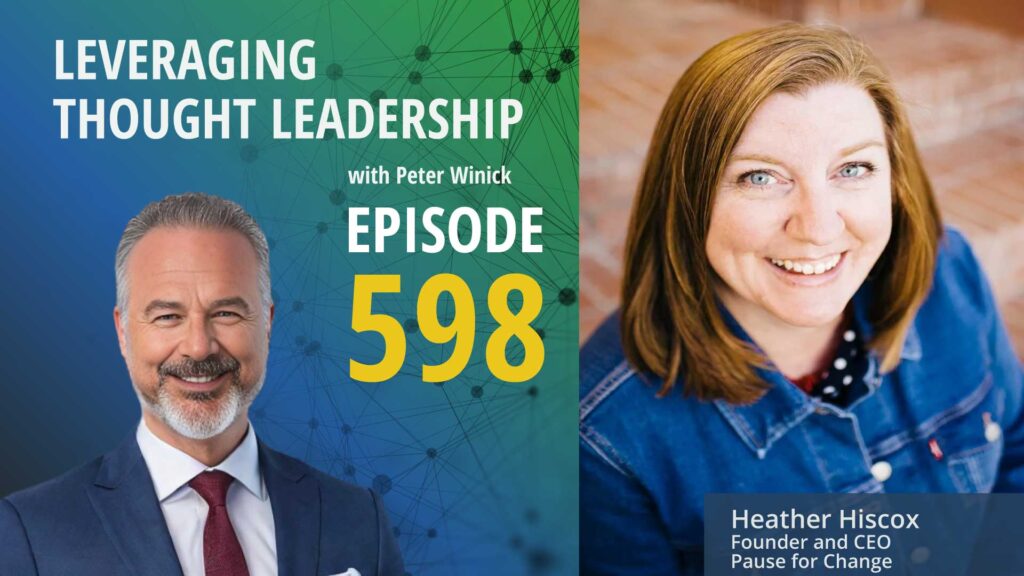
A Proven Framework for Meaningful Impact in Nonprofits and Beyond
In this episode, Heather Hiscox shares her journey from frustration to transformation, emphasizing the importance of relationships, active listening, and embracing imperfection in the change process.
What if the way we approach change is broken? Would you try something new? Or stick to what you know?
Join us as host Peter Winick sits down with Heather Hiscox, founder and CEO of Pause for Change and author of No More Status Quo: A Proven Framework to Change the Way We Change the World. Heather shares her journey of transforming frustration into a groundbreaking approach that’s helping changemakers address tough challenges in the nonprofit, government, and philanthropic sectors.
Heather’s insights began with a simple yet powerful question: “Why aren’t we working differently?” Years of seeing wasted efforts and weak results in the social sector pushed her to experiment. The result? The Pause framework—a tool for disrupting the status quo and creating meaningful impact. Her approach focuses on relationships, active listening, and rapid iteration, all built on a foundation of empathy and learning.
Heather discusses how entrepreneurs often miss key listening skills, and how fear of “not being ready” keeps leaders from publishing ideas and moving forward. Instead, she encourages taking risks, learning in real-time, and embracing new methods to achieve different outcomes. Her clients—nonprofits, local governments, and philanthropic organizations—typically approach her for one of two reasons: something’s broken, or they’re unsure what’s possible next. Heather uses her framework to guide them through the uncertainties, asking the right questions and driving real change.
When it comes to marketing, Heather’s strategy is driven by relationships and word of mouth. She’s not just waiting for clients to find her—she’s actively engaging them through LinkedIn, her online show The Possibility Project, and by knowing when to walk away from those who aren’t ready to embrace her message.
Heather’s work is a call to action for leaders ready to stop settling for the status quo and start making the impact they’ve always envisioned.
Three Key Takeaways:
Embrace new methods to create change: Heather emphasizes that traditional approaches in the social sector often fall short. To make real impact, leaders must ask different questions and take risks with new methods, like her Pause framework.
Relationships and listening are essential: Success hinges on building strong relationships and honing active listening skills. Whether in business or social change, empathetic listening and rapid iteration are key to solving complex problems.
Don’t fear imperfection: Many leaders hesitate to publish content or make moves because it “isn’t ready.” Heather advocates for moving forward despite uncertainty, learning in real-time, and refining as you go.
Heather has years of helping clients change how they think and work. If you are a thought leader, speaker, or author is your work creating sustainable change? Explore the topic more in this article by Peter Winick.
Transcript
Peter Winick And come. Welcome, welcome. This is Peter Winick. I’m the founder and CEO at Thought Leadership Leverage. And you’re joining us on the podcast today, which is Leveraging Thought Leadership. Today, my guest is Heather Hiscox. She is the founder and CEO of Paws for Change, an organization that helps changemakers address difficult challenges. Using the Pause framework to gain certainty about which solutions will create the greatest impact while using fewer resources and less time. She’s also the co-creator of The Possibility Project, an online conversion series about growing community of disruptive change makers. She speaks at conferences and events about shifting status quo practices in social impact organizations and was launched several ventures that benefit the social impact sector. She lives in Tucson with her partner and two children. There we go. So how did we get not to Tucson, but how did how did we what was the path we took to be leading Paws for Change and the Paws framework?
Heather Hiscox It really was born out of my own frustration working in this social sector and seeing the tremendous amount of waste and week impact that we were creating with the best of intentions with these ideals and best practices and ways that we traditionally address problems in social spaces and nonprofit, local government and philanthropy, and just seeing them fall short repeatedly and getting really frustrated and saying, why or why are we working differently? What else is out there? What is going on with our problem-solving strategies right now? What can we do differently to create change? And so, I really was kind of working to address that, that issue, those questions, and it just kept evolving with my learning. It was saying, we can do better, and here’s what that looks like and here’s more and here’s more and here’s more. So, let’s continue building.
Peter Winick So sitting there for a moment, because I’ve worked with lots and lots of people where you asked sort of the origin story. Right. And it’s some version of what you said, which, well, geez, I was suffering from this or I had this problem, or I couldn’t get over this or I had a toxic. But whatever it is they were, they wrote the book that they wanted to read that wasn’t available for them to read at the time. So they wrote it right as something along those lines. So, you know, then you extrapolate that, then you write the book and now you’re really serving a community of folks that you really, really can empathize with their pain points because you were on the other side of the table.
Heather Hiscox Absolutely. And that’s why I wrote the book No More Status Quo, because I that’s the number one feedback people give me when I do public speaking. When they read the book, they say, yeah, it’s like I’ve seen the same thing. I love and hate the sector. I love and hate the way that we do this work. And I now have language that I didn’t have. I feel validated. I feel seen and heard. As And how do you know? What do we do differently? What are the really specific, concrete action steps that we can take? And what are all those stories of inspiration that really show us what’s possible that’s made all the difference? So it honestly was the book and work that I wished I had more than a decade ago.
Peter Winick You know what you just said? There was I’ve had the language to describe this thing oftentimes that, you know, something’s resonating. When you say a, you know, people say something along with it. Wow, I thought it was just me, right? I didn’t know there was a word for that, or other people were experiencing that. And wow, now we’ve got some common language and now we have a way to address it. Now we have a way to work on it. Now we have a way I can share one, the angst or whatever it is that I’ve got with others in a non-judgmental way that defines it in a way that people go, Well, of course you do. According to that model. How could you not? Right.
Heather Hiscox Yes. And it’s I joke that it’s like The Matrix, you know, made that scene of the pill. Do what? The blueprint. The director.
Peter Winick Yeah. Yeah.
Heather Hiscox Really shifts people’s thinking to the point where they can’t go back to how they used to work because it doesn’t make any sense. You know, why would we build solutions without talking to people that will be most impacted by them? Duh. You know, why do we let all leaders make decisions when some of them are deeply removed from those same stakeholders inside and outside the organization? Why do we just build solutions in a vacuum for months and years without actually testing the embedded assumptions?
Peter Winick Does that love what you’re saying about Unsee? Because one of the things that I believe that, you know, grateful leadership, once you expose the idea to the right population, they can never see the world as they did before. Right. Because it’s like like, that’s so glaringly obvious. Now there’s a word for that. Now, the word might be psychological safety. It might be agility, it might be whatever. Like, yeah, I can’t ever imagine not thinking about things that way before. Like, yeah, it’s that makes perfect sense. So move to the that’s sort of the origin of the ideas and the thought leadership and the problems that it’s always talk about sort of the things that you’ve tested until you landed where you are today from a business model standpoint, because just you just could you have great ideas that actually does something, doesn’t mean that that in and of itself is a viable business.
Heather Hiscox No, definitely. Yeah. It’s been a lot of experimentation over the last 13 years. I started five businesses in the last 13 years. So just so much experience of what works and what doesn’t. How do I listen to my customer? You know, one of the some of the biggest lessons that I have learned are it’s all about relationships. That’s the keys to success. So that’s all business and everything is relationships. I’ve seen so many other entrepreneurs, the businesses close the deal, move on, close the deal, move on, where I know how we create optimal value. And what’s interesting about my framework is I use it for my business. I think about what are my uncertainties, who do I need to go engage with? Who do I learn from? How do I do those empathetic conversations? It’s like the lean startup methodology. It’s the lean, lean canvas, the business model canvas. How do I rapidly iterate? How do I identify okay, I could create this tweet, I could adjust my language, I could provide this. But what are those assumptions? How do I test those assumptions before I launched, before I grow? And I think that’s what a lot of entrepreneurs are missing, are some of those key listening skills. How do we listen empathetically? How do I listen actively and then how do I respond and how do I test before I build? And so I is the whole joke of like, you eat your own dog food, heaps of my own dog food where I’m just on this learning journey and very iterative and that’s what I expect of my clients as well.
Peter Winick So that testing piece, I agree with you, but I think there people live on a continuum of. You know, perfectionist to serve the more creative right to the perfectionist won’t put anything out to anyone. Meaning in an email. In a letter, you know, whatever. Until it’s perfect, until it’s to the 11th decimal, until it’s whatever. And I think there are some pros to that. But like anything else, there are some cons to that. And I think your sort of, you know, minimum viable lean startup, whatever, you got to get your stuff out there. And the way I always think about it is it’s really cheap to be stupid or really it’s expensive to be stupid later. And sometimes people are inadvertently stupid later because, you know, they’re building in a vacuum, in isolation. They’re going and going and going and toiling for months, even if it’s not hard cost. But they’re not taking into account the soft cost. And then they unleash the idea thinking it’s the greatest thing ever and thud. And then you get the feedback and you’re like, Jeez, wouldn’t that feedback have been valuable eight months ago when you could have done something with it? So how do you how do you balance that out or encourage folks to be a little bit more lean, if you will?
Heather Hiscox Well, I say, you know, I say the same thing. Do you want the hot mess now or later? Because it’s going to come back and bite you. It doesn’t it doesn’t disappear like it exists. It’s going to come back. You will find it. And I use, you know, a lot of case studies and examples and, you know, my work with local government, the typical way that a lot of people will create new change is through like City of Hayward, for example. They wanted to create a program focused on hoarding. Right? So they want to say like, how do we.
Peter Winick Hoarding according okay, yeah.
Heather Hiscox Individuals that had a hoarding disorders. And the typical way that they would build a program, any type of new program is they would say, all right, we have ten months, we have at $100,000, we’re going to create a 20 person task force and address this challenge. And the team that I got to work with was a team of four people. We spent about $6,500 and their actual costs of paying staff. And in about 4 to 6 weeks we learned that they should not copy this best practice program, which we uncovered was actually not working, that no one knew, even though this program had won awards on a conference stage, even though it had been featured by local political leaders. When they worked with us, they said, Don’t tell anyone, but it’s actually not working. And the team was sharp. And so when I had those two examples of, you know, traditional ways of working and the reality of new problem-solving skills, it’s a no brainer. Leaders see the difference. They see their retention and rejuvenation in their team members. They see that collective joint effort. So the results, they don’t have to wait months and years to see the results. They can see it in hours and weeks. And so the proof’s really in the pudding of really taking those risks of the learning in different ways, asking different question. And you get you get totally different results because you’re using a different entire method.
Peter Winick And if you’re enjoying this episode of Leveraging Thought Leadership, please make sure to subscribe. If you’d like to help spread the word about our podcast, please leave a five-star review at ratethispodcast.com/ltl and share it with your friends. We’re available on Apple Podcasts and on all major listening apps as well as that thought leadership leverage.com/podcast.
Peter Winick And so in terms of business models, tell me a little about like who’s paying you to do what, right? So I get the market, I get the sort of the problem case, if you will, when it comes down to it, what types of organizations are paying you for what sorts of interventions and what’s the outcome? What’s the benefit?
Heather Hiscox Yeah, it’s I work with nonprofit organizations, local governments and philanthropic foundations all across the U.S.. And what they typically bring me to do, or it kind of falls in two buckets. The first is this is not working. You know, team members are not showing up for our programs. Donors are not lining up to make gifts. We’re not getting traction. There’s something that’s broken within the organization. We want to reach.
Peter Winick They already know that, right? So they’re coming to you because something what used to always work is in we keep doing the same thing and getting worse outcome. So there’s already a metric in place that says, yeah, this is not good.
Heather Hiscox Yeah, there’s a painful results or painful symptom, right, that is working or the other way is there’s an opportunity. What if we. What might be possible if and so it’s not the you know, could we build it because they can build a lot of stuff, but should we build it? Is this even worth our time? Resources, money, all of that. And so we get to use the framework to really answer the shaver questions. Can we resuscitate and reimagine? Should we build? What could we build? And usually I work with.
Peter Winick Let me just interrupt you there. But so just out of curiosity. There’s those that something’s broken. Let’s fix it. My house got robbed. I guess I should get a burglar to, you know, an alarm system or whatever, and then others that are more strategic, forward thinking, etc., etc., etc., saying it’s not quite broken. But I wonder what the I wonder if dot, dot, dot, what’s the breakdown of what percentage come to you with the broken thing, which. I think there’s a better way thing.
Heather Hiscox And it’s about 5050. They really say this well and there is a spectrum. But should some element of internal or external organizational dynamics that are at play? Yeah. Yeah. And I typically work with leaders within those organizations, within city government. I usually work with the assistant city manager, city manager directly. I usually work with like a director, CEO of a nonprofit, and I usually work with like a director or like a board member of, of a nonprofit that like philanthropy. So yeah, it really varies. But they’re the people that are deeply embedded in the solutions. You know, they’re really driven to have a different option, different outcome.
Peter Winick Got it. Got it. And what tell me a little bit about because this is the area of the business that most people struggle the most all leaders struggle the most is sales, marketing, business development, that side of the house. So you clearly you’ve got a good market, you’ve got good content, you’ve got good thought. Leadership. What is what is it that you’re doing or not doing on the marketing side that’s working for you?
Heather Hiscox Yeah, you know, it’s really interesting after doing this for so many years, I mean, it’s a really high percentage now of word of mouth is how my business comes to me is these leaders talk to each other and they say, I’ve got this thing that’s not working or we want to explore this opportunity right now. It has been fantastic. I also, you know, have a presence on LinkedIn posting and sharing with people some of those outcomes and strategies I’m using. And then with the online talk show that I host possibility projects, it’s all aligned around and under the same umbrella of meeting frustrated changemakers where they are. Right. You know, okay, you’re not alone. You want something new? Read the book. You want to bring me in and I can help you. Bring me in. And there’s this talk show where it’s many, many people from all around the globe that are also frustrated. They’re also wanting to ask these big, bold questions and really stretch what’s possible. And so I find that it kind of falls into those different buckets of reaching people where they are on their journey. Are they at this early awareness? Are you take action? Maybe? Have they tried something and it didn’t work? And now I’m sort of the Plan B, there’s a whole variety of ways that people come to me, but I find that the referrals are a huge portion of my business, which is great.
Peter Winick Yeah. No, and I think the referral issue is, you know, there’s a flywheel effect or a compounding effect where, like you said, you’ve been doing this for a number of years. So even though you might not know exactly where the next five deals will come from, the data shows you that they’re going to come from people I’ve worked with before can tell you which ones at what time. But it’s was I predictable as a as an out. It sort of is a benefit of longevity, if you will.
Heather Hiscox Yes. And I think a lot of entrepreneurs forget that piece. They don’t do that. They don’t invest in relationship building. And I’m still very connected to clients that I work with a decade ago. Yeah, they can come to me. So I really I really care. I care deeply about the outcomes of my teams, my team members, my leaders there. And people often don’t ask. I think we forget to ask for testimonials. We ask for that feedback. We forget to debrief really intentionally with our clients to find our own growth opportunities. And where are those places where we’re excelling and where the places where we meet we need to shift. And if you don’t ask for that feedback and then when it’s good stuff, we don’t promote it and gather it. And when it’s bad stuff, we just kind of gloss over it.
Peter Winick But even that testimonial piece, I think, one, there’s something about testimonials that give people the warm and fuzzy, like they interact with somebody, they go, I want to hire that person. And then at some point, you know, they’re thinking about thinking about like, I kind of need some validation. When they read the testimonial, I go, look at all those amazing things that other people like me or people that I admire or people with similar issues to me have said about them. That makes me feel good because I need validation that I’m not, you know, risking money and time and energy and and effort. And then the other piece of testimonials I think is, is really important. But they’d be the onus or the burden is on the thought leader is to ask for them and to make that a process right. You wouldn’t ever not deliver an invoice or deliver a deliverable. There needs to be a point in the engage where you say this is the optimal point for me to ask that person. They’ve already tasted something good. They’ve experienced the benefit of working with me. It’s appropriate for me to ask because they’re not going to just most of the time, like 90% give you a testimonial. You have to sort of prod a bit.
Heather Hiscox Absolutely. I’m going to have a clear email that I sent that gives prompts and you kind of need that to get going. It’s like when someone comes to you and says rather recommendation letter.
Peter Winick Yeah, yeah, yeah, yeah.
Heather Hiscox Like lead to a proposal for a prospective employer. You’re like, I don’t even know where to get started. And you can’t just say like, they’re a nice person, right? You have to be really detail explicit about their right. An asset.
Peter Winick Someone like that would say, I’m looking for something that covers these five bullet points. Wink, wink.
Heather Hiscox Right, Exactly. Exactly. It’s like, what was it like preparing for the event? What was the day of facilitation and experience? What were the outcomes and result that I that you see? And I think that also, you know, we don’t even know the ripple effect of what we create often. Yeah, it’s validating and it’s nourishing. We do this work to make a difference. We do this work to make change so we don’t ask for that. It’s sort of like the circle is incomplete. We’re not really understanding this, what we create. And I think also part of the entrepreneurial journey is figuring out who you should repel and who you should are, attracts and know or messaging and experimentation. We have to learn, you know, like those are not my people. They want to run for. My messaging is it’s intimidating or it’s threatening or they’re not ready. Great. Don’t waste my time. We’re the people that are like, okay. Excellent. Come here. Let’s keep talking. Let’s go.
Peter Winick I think I got it right because I think for many entrepreneurs early on, everybody’s a customer, right? Or everybody could be a client because they need the business. But eventually you mature enough to go, I could really crush it for that person because they’re like 50 other people I’ve worked with. B I think I could probably help them, but there’s no guarantee. But then there’s that other one of like. And my lead single problem Do I even want to help this person? They’ve given me some signals along the way and we’re not even engaged that they’re going to be high maintenance. I’m not going to be able to please them. They’re going to be a pain in the butt of whatever, whatever. And there’s maturity that comes along with saying I you know, I don’t think I’m for you. Right. And then the confidence that comes with I am absolutely for you.
Heather Hiscox Yes. On a personal level. And, you know, I love on my network, I can refer those people to other places. Right. I don’t just leave them high and dry. I say, and you should look at these other options. So that makes me feel like I’m also contributing to their journey instead of just saying no.
Peter Winick Real of the potential problem child to a competitor you hate, right?
Heather Hiscox That’s it. Don’t do that.
Peter Winick Well, this has been awesome. Appreciate your time, Heather. And any final words of wisdom to people on their way to where you are?
Heather Hiscox Yeah, I think it’s you know, really just trust your gut. I find that clarity. What’s that clarity around your message, around your customer, around your packaging and knowing that it’s always going to evolve? I think that’s so important is to have that clarity. But know that those tests exist, those ways that you can experiment exist. You can try different things and collect those data points that really will shift your business.
Peter Winick Now. I love that because it’s very rare that a father’s making a bet the House decision. We’re usually making small bets that we could learn from as opposed to this is it that’s going to work or I’m shot in the door. There’s a right like it’s so everything is a little bit of a risk and an investment and a small bet that leads to incremental change. It’s not exponential and won’t turn of the dial.
Heather Hiscox Exactly. Exactly. Yes.
Peter Winick Look what we should it. Thanks for coming on board today and best of luck to you. Thank you, Heather.
Heather Hiscox Thank you.
Peter Winick To learn more about Thought Leadership Leverage, please visit our website at thoughtleadershipleverage.com to reach me directly. Feel free to email me at Peter at thoughtleadershipleverage.com and please subscribe to leveraging thought leadership on iTunes or your favorite podcast app to get your weekly episode automatically.


